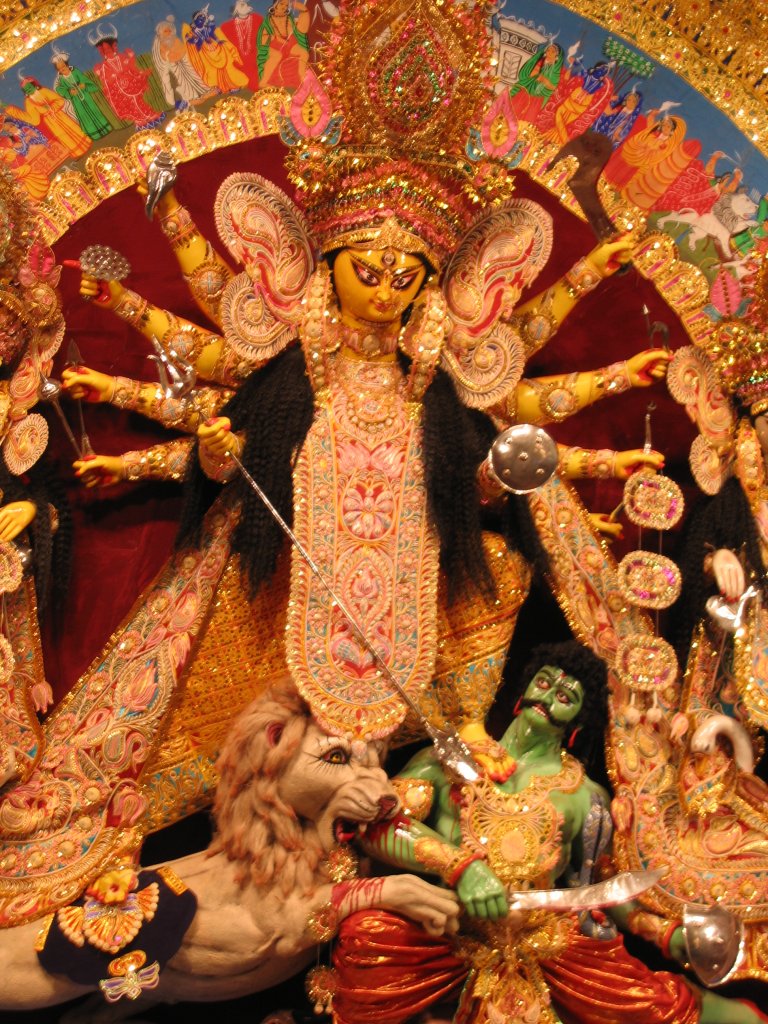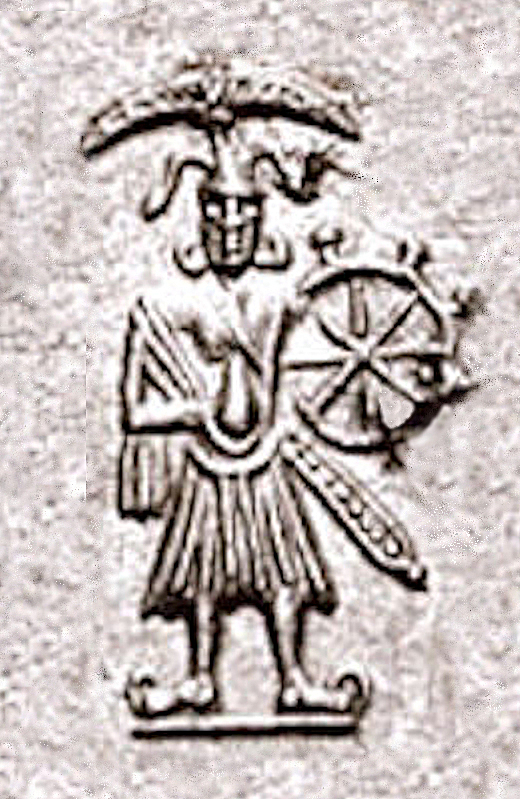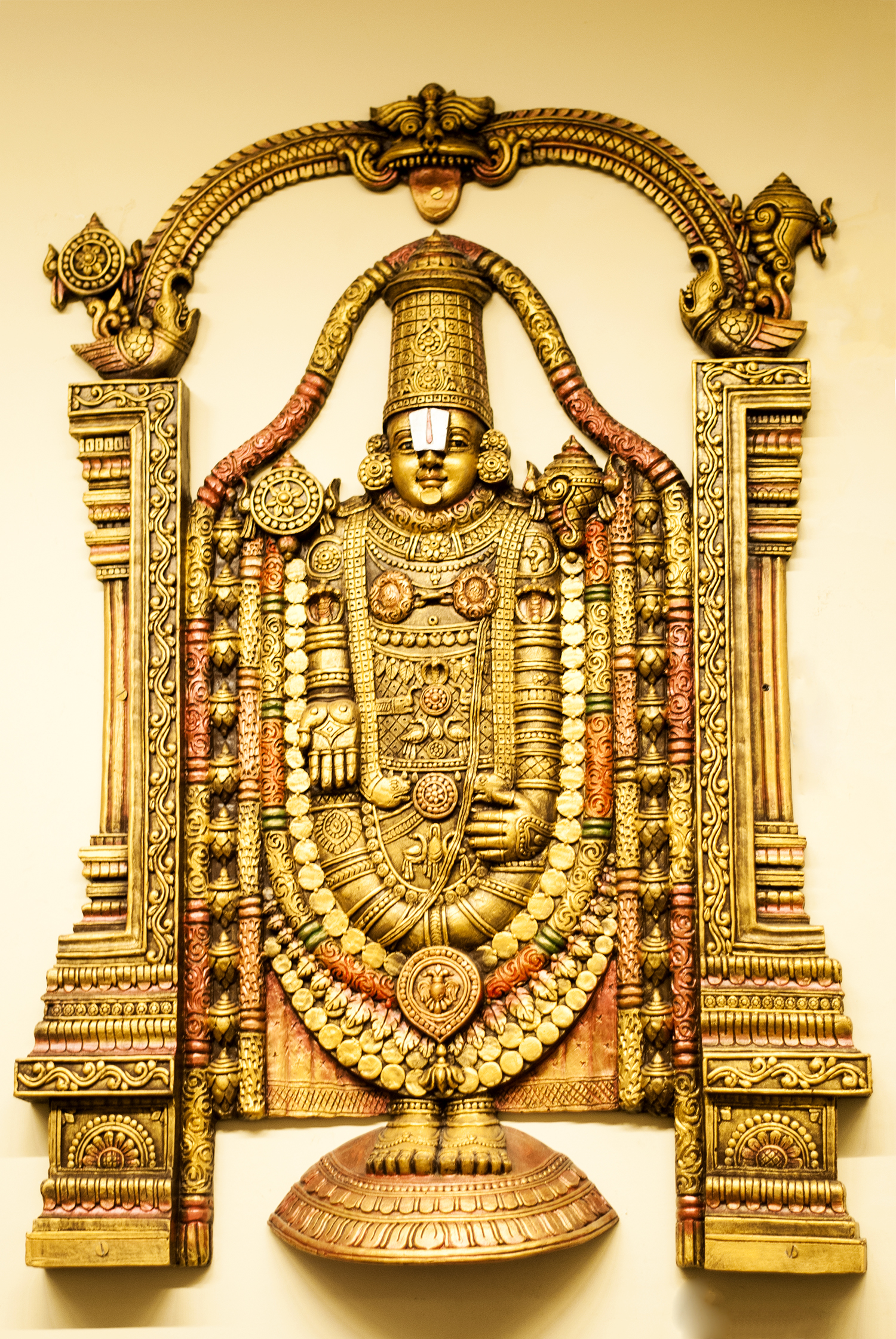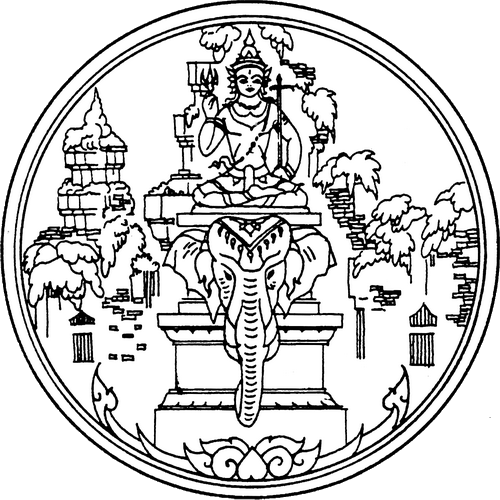|
Grāmadevatā
A gramadevata () is the tutelary deity of a given locality in Hinduism, primarily worshipped in the villages of India. Of diverse origins, gramadevatas are regarded to protect the inhabitants of their villages from bandits, epidemics, and natural disasters when propitiated, failing which they are believed to cause these afflictions. A gramadevata is typically female in South India. In this region, a village goddess, acting as a fertility figure, is enshrined, and a guardian of the village is situated at the village boundary. Etymology The term gramadevata is derived from the Sanskrit words grāma, "village, village settlement" and devatā, "deity". Development The earliest appearance of the " Mother Goddess" found in South Asia is in Mehrgarh in the form of female terracotta figurines dating to the 4th millennium BCE. These figurines are believed to represent the "Mother Goddess." Similar female figurines are found in 3rd-2nd millennium figures from Harappan civilization ... [...More Info...] [...Related Items...] OR: [Wikipedia] [Google] [Baidu] |
Mariamman
Mariamman, often abbreviated to Amman (), is a Hindu Dravidian folk religion List of rain deities, goddess of weather, predominantly venerated in the rural areas of South India. Her festivals are held during the late summer/early autumn season of Ādi throughout Tamil Nadu and the Deccan region, the largest being the ''Ādi Thiruviḻa''. Her worship mainly focuses on bringing rains and curing such serious diseases as cholera, smallpox, and chicken pox. Mariamman is worshipped in accordance with local traditions such as ''Pidari'' or the ''Grāmadevatā, Gramadevatai.'' She is considered as a guardian deity (kaval deivam) by many South Indian village dwellers. She is also the regional form of Hindu goddess Parvati. Her consort is lord Shiva. At samayapuram, she is the sister of Ranganathaswamy. She is also worshipped in Karnataka as Marikambe, who is a manifestation of Adi-Parashakti or Mahadevi. Origin Mariamman's worship originated in the traditions of Dravidian folk reli ... [...More Info...] [...Related Items...] OR: [Wikipedia] [Google] [Baidu] |
Sri Renuka Parameshwari Urchavam
Shri (; , ) is a Sanskrit term denoting resplendence, wealth and prosperity, primarily used as an honorific. The word is widely used in South and Southeast Asian languages such as Assamese, Meitei ( Manipuri), Marathi, Malay (including Indonesian and Malaysian), Javanese, Balinese, Sundanese, Sinhalese, Thai, Tamil, Telugu, Odia, Assamese, Punjabi, Hindi, Bengali, Nepali, Malayalam, Kannada, Sanskrit, Pali, Khmer, and also among Philippine languages. It is usually transliterated as ''Sri'', ''Sree'', ''Shri'', ''Shiri'', ''Shree'', ''Si'', or ''Seri'' based on the local convention for transliteration. In Tamil it evolved to Tiru. The term is used in Indian subcontinent and Southeast Asia as a polite form of address equivalent to the English "Mr." in written and spoken language. "Shri" is also used as a title of veneration for deities or as honorific title for individuals. "Shri" is also an epithet for Hindu goddess Lakshmi, while a '' yantra'' or a mystical ... [...More Info...] [...Related Items...] OR: [Wikipedia] [Google] [Baidu] |
Durga
Durga (, ) is a major Hindu goddess, worshipped as a principal aspect of the mother goddess Mahadevi. She is associated with protection, strength, motherhood, destruction, and wars. Durga's legend centres around combating evils and demonic forces that threaten peace, prosperity, and dharma, representing the power of good over evil. Durga is believed to unleash her divine wrath against the wicked for the liberation of the oppressed, and entails destruction to empower creation. Durga is seen as a motherly figure and often depicted as a beautiful woman, riding a lion or tiger, with many arms each carrying a weapon and often defeating demons. She is widely worshipped by the followers of the goddess-centric sect, Shaktism, and has importance in other denominations like Shaivism and Vaishnavism. The most important texts of Shaktism, Devi Mahatmya and Devi Bhagavata Purana, revere Devi (the Goddess) as the primordial creator of the universe and the Brahman (ultimate truth and reali ... [...More Info...] [...Related Items...] OR: [Wikipedia] [Google] [Baidu] |
Ganesha
Ganesha or Ganesh (, , ), also known as Ganapati, Vinayaka and Pillaiyar, is one of the best-known and most worshipped Deva (Hinduism), deities in the Hindu deities, Hindu pantheon and is the Supreme God in the Ganapatya sect. His depictions are found throughout India. Hindu denominations worship him regardless of affiliations. Devotion to Ganesha is widely diffused and extends Ganesha in world religions, to Jains and Buddhists and beyond India. Although Ganesha has many attributes, he is readily identified by his Asiatic Elephant, elephant head and four arms. He is widely revered, more specifically, as the remover of obstacles and bringer of good luck; the patron of The arts, arts and Science, sciences; and the Deva (Hinduism), deva of intellect and wisdom. As the god of beginnings, he is honoured at the start of rites and ceremonies. Ganesha is also invoked during writing sessions as a patron of letters and learning., Vigna means obstacles Nasha means destroy. These ideas ar ... [...More Info...] [...Related Items...] OR: [Wikipedia] [Google] [Baidu] |
Parvati
Parvati (, , IPA: /Sanskrit phonology, pɑɾʋət̪iː/), also known as Uma (, , IPA: Sanskrit phonology, /ʊmɑː/) and Gauri (, , IPA: /Sanskrit phonology, gə͡ʊɾiː/), is one of the principal goddesses in Hinduism, revered as the Devi, goddess of power, energy, nourishment, harmony, love, beauty, devotion, and motherhood. Along with Lakshmi and Saraswati, Sarasvati, she forms the trinity, known as the Tridevi. From her first appearance as a goddess during the Itihasa-Purana, epic period (400 BCE – 400 CE), Parvati is primarily depicted as the consort of the god Shiva. According to various Puranas, Parvati is the reincarnation of Sati (Hindu goddess), Sati, Shiva's first wife, who relinquished her body to sever familial ties with her father, Daksha, after he had insulted Shiva. Parvati is often equated with the other goddesses such as Sati, Uma, Kali and Durga and due to this close connection, they are often treated as one and the same, with their stories frequently ove ... [...More Info...] [...Related Items...] OR: [Wikipedia] [Google] [Baidu] |
Lakshmi
Lakshmi (; , , sometimes spelled Laxmi, ), also known as Shri (, , ), is one of the principal goddesses in Hinduism, revered as the goddess of wealth, fortune, prosperity, beauty, fertility, sovereignty, and abundance. She along with Parvati and Sarasvati, form the trinity of goddesses called the Tridevi. Lakshmi has been a central figure in Hindu tradition since pre-Buddhist times (1500 to 500 BCE) and remains one of the most widely worshipped goddesses in the Hindu pantheon. Although she does not appear in the earliest Vedic literature, the personification of the term '' shri''—auspiciousness, glory, and high rank, often associated with kingship—eventually led to the development of Sri-Lakshmi as a goddess in later Vedic texts, particularly the ''Shri Suktam''. Her importance grew significantly during the late epic period (around 400 CE), when she became particularly associated with the preserver god Vishnu as his consort. In this role, Lakshmi is seen as the ide ... [...More Info...] [...Related Items...] OR: [Wikipedia] [Google] [Baidu] |
Shiva
Shiva (; , ), also known as Mahadeva (; , , Help:IPA/Sanskrit, [mɐɦaːd̪eːʋɐh]) and Hara, is one of the Hindu deities, principal deities of Hinduism. He is the God in Hinduism, Supreme Being in Shaivism, one of the major traditions within Hinduism. Shiva is known as ''The Destroyer'' within the Trimurti, the Hinduism, Hindu trinity which also includes Brahma and Vishnu. In the Shaivite tradition, Shiva is the Supreme Lord who creates, protects and transforms the universe. In the goddess-oriented Shaktism, Shakta tradition, the Supreme Goddess (Devi) is regarded as the energy and creative power (Shakti) and the equal complementary partner of Shiva. Shiva is one of the five equivalent deities in Panchayatana puja of the Smarta Tradition, Smarta tradition of Hinduism. Shiva has many aspects, benevolent as well as fearsome. In benevolent aspects, he is depicted as an Omniscience, omniscient yogi who lives an Asceticism#Hinduism, ascetic life on Kailasa as well as a house ... [...More Info...] [...Related Items...] OR: [Wikipedia] [Google] [Baidu] |
Shaivism
Shaivism (, , ) is one of the major Hindu denominations, Hindu traditions, which worships Shiva as the Para Brahman, supreme being. It is the Hinduism#Demographics, second-largest Hindu sect after Vaishnavism, constituting about 385 million Hindus, found widely across South Asia (predominantly in South India, Southern India), Sri Lanka, and Nepal.Keay, p.xxvii. The followers of Shaivism are called Shaivas or Shaivites. According to Chakravarti, Shaivism developed as an amalgam of pre-Aryan religions and traditions, Vedic Rudra, and post-Vedic traditions, accommodating local traditions and Yoga, puja and bhakti. According to Bisschop, early shaivism is rooted in the worship of vedic deity Rudra. The earliest evidence for sectarian Rudra-Shiva worship appears with the Pasupata (early CE), possibly owing to the Origins of Hinduism, Hindu synthesis, when many local traditions were aligned with the Brahmanism, Vedic-Brahmanical fold. The Pāśupata movement rapidly expanded through ... [...More Info...] [...Related Items...] OR: [Wikipedia] [Google] [Baidu] |
Vaishnavism
Vaishnavism () ), also called Vishnuism, is one of the major Hindu denominations, Hindu traditions, that considers Vishnu as the sole Para Brahman, supreme being leading all other Hindu deities, that is, ''Mahavishnu''. It is one of the major Hindu denominations along with Shaivism, Shaktism, and Smartism. Its followers are called Vaishnavites or ''Vaishnava''s (), and it includes sub-sects like Krishnaism and Ramanandi Sampradaya, Ramaism, which consider Krishna and Rama as the supreme beings respectively. According to a 2020 estimate by The World Religion Database (WRD), hosted at Boston University’s Institute on Culture, Religion and World Affairs (CURA), Vaishnavism is the largest Hindu sect, constituting about 399 million Hindus. The ancient emergence of Vaishnavism is unclear, and broadly hypothesized as a History of Hinduism, fusion of various regional non-Vedic religions with worship of Vishnu. It is considered a merger of several popular non-Vedic theistic traditio ... [...More Info...] [...Related Items...] OR: [Wikipedia] [Google] [Baidu] |
Vishnu
Vishnu (; , , ), also known as Narayana and Hari, is one of the Hindu deities, principal deities of Hinduism. He is the supreme being within Vaishnavism, one of the major traditions within contemporary Hinduism, and the god of preservation (sattva). Vishnu is known as ''The Preserver'' within the Trimurti, the triple deity of Para Brahman, supreme divinity that includes Brahma and Shiva.Gavin Flood, An Introduction to Hinduism' () (1996), p. 17. In Vaishnavism, Vishnu is the supreme Lord who creates, protects, and transforms the Hindu cosmology, universe. Tridevi is stated to be the energy and creative power (Shakti) of each, with Lakshmi being the equal complementary partner of Vishnu. He is one of the five equivalent deities in Panchayatana puja of the Smarta tradition of Hinduism. According to Vaishnavism, the supreme being is with qualities (Saguna Brahman, Saguna), and has definite form, but is limitless, transcendent and unchanging absolute Brahman, and the primal Atma ... [...More Info...] [...Related Items...] OR: [Wikipedia] [Google] [Baidu] |
Venkateswara
Venkateswara (, ), also known as Venkatachalapati, Venkata, Balaji and Srinivasa, is a Hindu deity, described as a form or avatar of the god Vishnu. He is the presiding deity of Venkateswara Temple, Tirumala, Venkateswara Temple, Tirupati. His consorts, Padmavati (Hinduism), Padmavati and Bhudevi, are avatars of the goddess Lakshmi, the consort of Vishnu. Etymology and other names Venkateswara literally means "Lord of Venkata (hill), Venkata". The word is a combination of the words ''Venkata'' (the name of a hill in Andhra Pradesh) and ''iśvara'' ("Lord"). According to the ''Brahmanda Purana, Brahmanda'' and ''Bhavishya Purana, Bhavishyottara'' Puranas, the word "Venkata" means "destroyer of sins", deriving from the Sanskrit words ''vem'' (sins) and ''kata'' (power of immunity). Venkateswara is known by many names such as Srinivasa (''in whom Lakshmi dwells''), Narayana (''The Primordial One''), Perumal (''the great lord''), Malayappa (''the lord of the Hill'') and Govinda ( ... [...More Info...] [...Related Items...] OR: [Wikipedia] [Google] [Baidu] |
Hindu Deities
Hindu deities are the gods and goddesses in Hinduism. Deities in Hinduism are as diverse as its traditions, and a Hindu can choose to be polytheistic, pantheistic, monotheistic, monistic, even agnostic, atheistic, or humanist. Julius J. Lipner (2009), Hindus: Their Religious Beliefs and Practices, 2nd edition, Routledge, , p. 8; Quote: "(...) one need not be religious in the minimal sense described to be accepted as a Hindu by Hindus, or describe oneself perfectly validly as Hindu. One may be polytheistic or monotheistic, monistic or pantheistic, even an agnostic, humanist or atheist, and still be considered a Hindu." The terms and epithets for deities within the diverse traditions of Hinduism vary, and include Deva, Devi, Ishvara, Ishvari, Bhagavān and Bhagavati. The deities of Hinduism have evolved from the Vedic era (2nd millennium BCE) through the medieval era (1st millennium CE), regionally within Nepal, Pakistan, India and in Southeast Asia, and across Hinduism ... [...More Info...] [...Related Items...] OR: [Wikipedia] [Google] [Baidu] |









